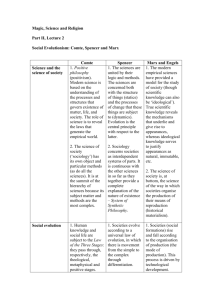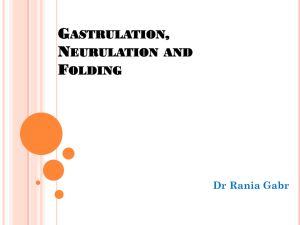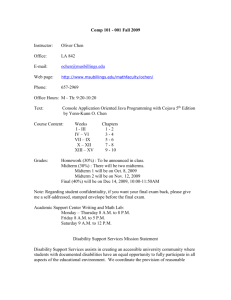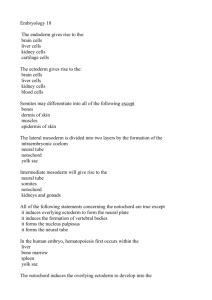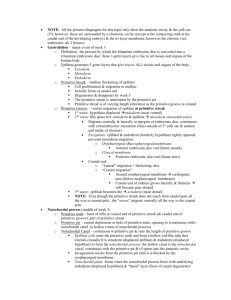3RD WEEK OF DEVELOPMENT
advertisement
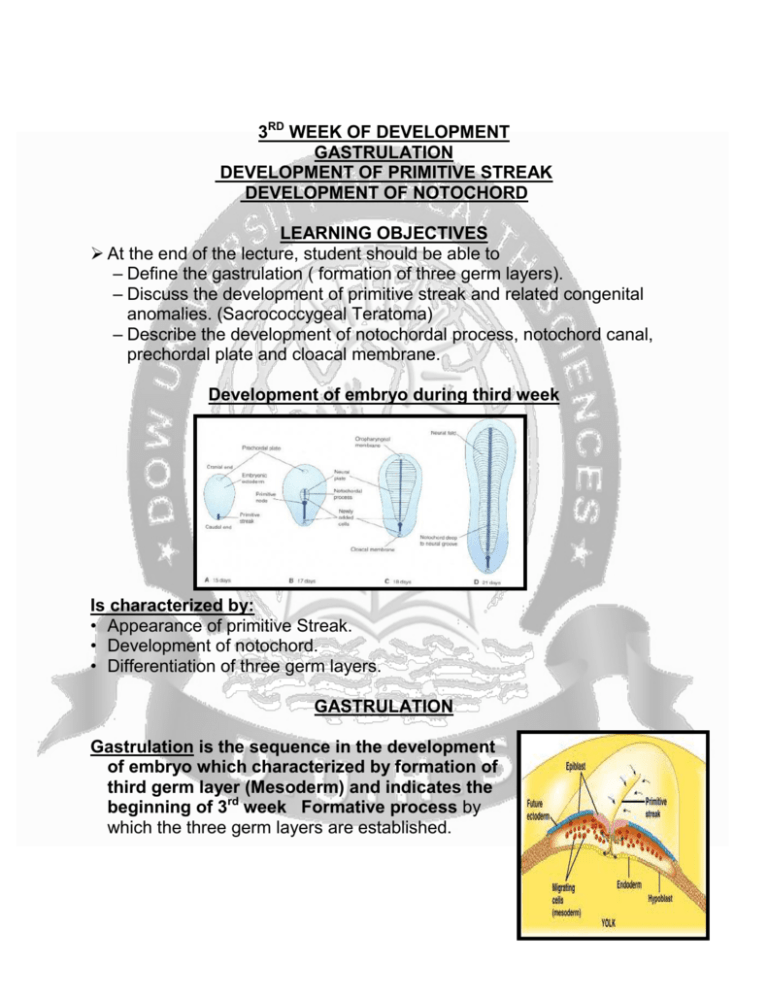
3RD WEEK OF DEVELOPMENT GASTRULATION DEVELOPMENT OF PRIMITIVE STREAK DEVELOPMENT OF NOTOCHORD LEARNING OBJECTIVES At the end of the lecture, student should be able to – Define the gastrulation ( formation of three germ layers). – Discuss the development of primitive streak and related congenital anomalies. (Sacrococcygeal Teratoma) – Describe the development of notochordal process, notochord canal, prechordal plate and cloacal membrane. Development of embryo during third week Is characterized by: • Appearance of primitive Streak. • Development of notochord. • Differentiation of three germ layers. GASTRULATION Gastrulation is the sequence in the development of embryo which characterized by formation of third germ layer (Mesoderm) and indicates the beginning of 3rd week Formative process by which the three germ layers are established. GASTRULATION • Bilaminar embryonic germ disc is converted into a trilaminar embryonic disc. • Extensive cell shape changes, rearrangement, movement, and changes in adhesive properties occur. • First sign of gastrulation is the formation of primitive streak . • • • • • FORMATION OF THE 3 “GERM” LAYERS Primitive streak (groove) on dorsal surface of epiblast Grastrulation: invagination of epiblast cells Days 14-15: they replace hypoblast becoming endoderm Day 16: mesoderm (a new third layer) formed in between Epiblast cells remaining on surface: ectoderm DEVELOPMENT OF PRIMITIVE STREAK Gastrulation is the first sign of beginning of 3rd week of development and characterized by the formation of Primitive Streak Epibalstic cells proliferate and invaginate inside between epiblastic and hypoblastic layers. Due to proliferation of epiblastic cells a linear thicking will be developed in mid line on the dorsal aspect of embryonic disc in caudal part, this is the beginning of development of Primitive streak DEVELOPMENT OF PRIMITIVE NODE Primitive streak develops into caudal 1/3 of embryo The epiblastic cells proliferate continuously and they are moving inward and increasing in number in mid line. The collection of epiblastic cells which change their shape from columnar to polygonal cells called Mesenchymal cells and they are collected at the cranial end of Primitive streak called as Primitive node • • • • PRIMITIVE NODE Cont… The moving surface cells first pile up to form a prominent bump known as the node. This occurs because the cells move along the top faster and sort of like crowds at a major concert. The node was discovered in mammals by Hensen and is appropriately named Hensen's node in rabbits and other organisms but is only referred to as the node in humans. PRIMITIVE GROOVE & PIT • The Mesenchymal cells continuously proliferate and added up to in the primitive steak as a result a groove develops in the primitive streak, the Primitive Groove. • Primitive groove grove extends towards cranial end and continuous with a depression with in the primitive node, the Primitive Pit ROLE OF PRIMITIVE STREAK Development of Primitive streak responsible for the identification of axes of embryo that is one can identified – Cranio-caudal axis – Dorsal and Ventral surfaces – right left sides. • • • FURTHER DEVELOPMENT OF MESENCHYMAL CELL From the deeper surface of primitive streak the cells detach form the primitive streak and assumed polygonal shaped and acquired amoeboid movement and have phagocytic activities. Mesenchymal cells form the supporting tissue of body and connective tissue frame of glands. Some of mesenchymal forms the Mesoblast (undifferentiated mesoderm) intra-embryonic or embryonic mesoderm REPLACEMENT OF HYPO & EPIBLASTIC CELLS • Cells from the primitive streak move inwards to the ventral surface at the roof of yolk sac and displace the hypoblastic cells and form the Embryonic Endoderm. • The cells of Epiblast remain and form the Embryonic Ectoderm. • That means all three germs layers, Ectoderm, Mesoderm and Endoderm from Epiblatic cells. FATE OF PRIMITIVE STREAK • Primitive streak forms the embryonic mesoderm up to 4th week of embryo, after that the formation of mesoderm diminish and ultimately regresses completely. • Sometime the primitive streak persists and result in congenital anomalies called as Sacrococcygeal Teratoma • • • • • • • Sacrococcygeal Teratoma Prevalence: 1 in 35,000 Gender: Female (80%) affected more as compare male. Morphology: Sacrococcygeal teratoma consists of cells which are derived from pluripotent primitive streak cells. These tumors contains tissues derived all three germ layers in incomplete stage of differentiation Can be diagnosed antenatally with of Ultrasonography. They can be removed by surgical procedure prognosis is good DEVELOPMENT NOTOCHORD • The mesenchymal cells from the primitive pit and primitive node migrate cranially in the midline between the epiblast (ectoderm) and hypoblast (endoderm) until these cells reach up to Prechordal plate • Prechordal plate, a small circular area of columnar endodermal cells where the ectoderm and endoderm are in contact. • The prechordal plate is the primordium of the oropharyngeal membrane which will lead to oral cavity DEVELOPMENT NOTOCHORD cont… • The cells constantly migrating from the primitive streak and node and form a solid cord of Notochordal process which soon acquires lumen, called as Notochordal Canal SEQUENCE OF EVENTS IN THE DEVELOPMENT OF NOTOCHORD • The Notochordal process elongates by invagination of cells from the primitive pit. • The primitive pit extends into the notochordal process, forming a Notochordal canal. • The notochordal process is now a cellular tube that extends cranially from the primitive node to the prechordal plate. • The floor of the notochordal process fuses with the underlying embryonic endoderm. SEQUENCE OF EVENTS IN THE DEVELOPMENT OF NOTOCHORD • The fused layers gradually undergo degeneration, resulting in the formation of openings in the floor of the notochordal process, which brings the notochordal canal into communication with the umbilical vesicle. • The openings rapidly become confluent and the floor of the notochordal canal disappears; the remains of the notochordal process form a flattened, grooved notochordal plate. SEQUENCE OF EVENTS IN THE DEVELOPMENT OF NOTOCHORD • Beginning at the cranial end of the embryo, the notochordal cells proliferate and the notochordal plate infolds to form the notochord. • The proximal part of the notochordal canal persists temporarily as the neurenteric canal, which forms a transitory communication between the amniotic and umbilical vesicle cavities. • When development of the notochord is complete, the neurenteric canal normally obliterates. SEQUENCE OF EVENTS IN THE DEVELOPMENT OF NOTOCHORD • The notochord becomes detached from the endoderm of the umbilical vesicle, which again becomes a continuous layer. INDUCER FOR THE DEVELOPMENT OF NOTOCHORD • Inducer/s is/ are factor/s which help or induce development of another structure. • In case of notochord the inducer is the signals from the primitive streak region induce notochordal precursor cells to form the notochord, a cellular rodlike structure. The molecular mechanism that induces these cells involves (at least) Shh signaling from the floor plate of the neural tube. FUNCTIONS OF NOTOCHORD • Defines the primordial longitudinal axis of the embryo and gives it some rigidity. • Provides signals that are necessary for the development of axial musculoskeletal structures and the central nervous system. • Contributes to the intervertebral discs. FATE OF NOTOCHORD • The notochord extends from the oropharyngeal membrane to the primitive node. • The notochord degenerates as the bodies of the vertebrae form, • but small portions of it persist as the nucleus pulposus of each intervertebral disc. NOTOCHORD ACT AS INDUCER • The notochord functions as the primary inductor (signaling center) in the early embryo. • The developing notochord induces the overlying embryonic ectoderm to thicken and form the neural plate, the primordium of the central nervous system (CNS). PLACES WHERE ECTODERM AND ENDODERM ARE DIRECT IN CONTACT • In embryo the mesoderm intervene between ectoderm and endoderm but there three places where ectoderm and endoderm are direct in contact – At the oropharyngeal membrane cranially – In the median plane cranial to the primitive node, where the notochordal process is located – At the cloacal membrane caudally REFERENCES • Keith L. Moore Developing Human 8th Edition Chapter-4 Pages 59 -65 THANK YOU

